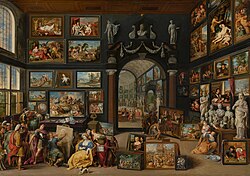
Back فنون أوروبا Arabic فنون اوروبا ARZ Еўрапейскае мастацтва BE Evropska umjetnost BS Lääne kunst ET Art en Europe French Arte occidentale Italian ಐರೋಪ್ಯ ಕಲೆ KN Европска уметност MK ਯੂਰਪ ਦੀ ਕਲਾ PA



| History of art |
|---|
| European art history |
|---|
The art of Europe, also known as Western art, encompasses the history of visual art in Europe. European prehistoric art started as mobile Upper Paleolithic rock and cave painting and petroglyph art and was characteristic of the period between the Paleolithic and the Iron Age.[1] Written histories of European art often begin with the Aegean civilizations, dating from the 3rd millennium BC. However a consistent pattern of artistic development within Europe becomes clear only with Ancient Greek art, which was adopted and transformed by Rome and carried; with the Roman Empire, across much of Europe, North Africa and Western Asia.[2]
The influence of the art of the Classical period waxed and waned throughout the next two thousand years, seeming to slip into a distant memory in parts of the Medieval period, to re-emerge in the Renaissance, suffer a period of what some early art historians viewed as "decay" during the Baroque period,[3] to reappear in a refined form in Neo-Classicism[4] and to be reborn in Post-Modernism.[5]
Before the 1800s, the Christian church was a major influence on European art, and commissions from the Church provided the major source of work for artists. In the same period there was also a renewed interest in classical mythology, great wars, heroes and heroines, and themes not connected to religion.[6] Most art of the last 200 years has been produced without reference to religion and often with no particular ideology at all, but art has often been influenced by political issues, whether reflecting the concerns of patrons or the artist.
European art is arranged into a number of stylistic periods, which, historically, overlap each other as different styles flourished in different areas. Broadly the periods are, Classical, Byzantine, Medieval, Gothic, Renaissance, Baroque, Rococo, Neoclassical, Modern, Postmodern and New European Painting.[6]
- ^ Oosterbeek, Luíz. "European Prehistoric Art". Europeart. Retrieved 4 December 2012.
- ^ Boardman, John ed., The Oxford History of Classical Art, pp. 349-369, Oxford University Press, 1993, ISBN 0198143869
- ^ Banister Fletcher excluded nearly all Baroque buildings from his mammoth tome A History of Architecture on the Comparative Method. The publishers eventually rectified this.
- ^ Murray, P. and Murray, L. (1963) The Art of the Renaissance. London: Thames & Hudson (World of Art), p. 9. ISBN 978-0-500-20008-7. "...in 1855 we find, for the first time, the word 'Renaissance' used — by the French historian Michelet — as an adjective to describe a whole period of history and not confined to the rebirth of Latin letters or a classically inspired style in the arts."
- ^ Hause, S. & Maltby, W. (2001). A History of European Society. Essentials of Western Civilization (Vol. 2, pp. 245–246). Belmont, CA: Thomson Learning, Inc.
- ^ a b "Art of Europe". Saint Louis Art Museum. Slam. Retrieved 4 December 2012.